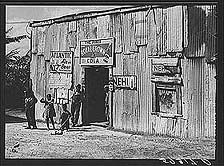
The impact
this new system had on common cultural life was, in great part, what Marion
Post Wolcott was looking to capture in her photos of Belle Glade. In a
sense, she was looking to document just the phenomenon Hazzard-Gordon
writes of; how the labor experience infused the "character and psychology"
of everyday life. She wrote of Belle Glade in a letter to Roy Stryker
during her trip to Florida in early 1939; in it, she articulates a need
to grasp an angle on the migratory life of which she felt the FSA didn't
have enough material:
I don't
remember that we have much of this. I don't mean just showing the
various operations of the packing and grading processes. I mean the
life of the packing house- the hanging around, the "messing around",
the gambling, the fighting, the "sanitary" conditions, the effects
of the very long work stretch, the rest periods, their lunch- etc.
(MPW to RES, Belle Glade, ca. 3 Feb. 1939, p. 2; Stryker Collection;
University of Louisville)
She has fastened
onto a key principle behind the FSA photographers' expansion beyond the
subject matter of government projects and laborers at work- that leisure
activities were as telling about the life of the migrant laborer as the
fields in which he picked, and as such, deserved attention.
| |
 |
|
Library
of Congress, USF34-0573170D
|
Even the
way she captioned this image of a jook joint in Canal Point, "living quarters,
store and 'juke joint' for migratory laborers," indicates that she had
come to grasp how integrated the various aspects of the migrant laborer's
lifestyle were. The same space functioned for private leisure, home, and
commercial purposes.
 |
|
2
|
|
|
 |
•
Juliet Gorman, May 2001 •
|
|

|